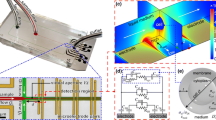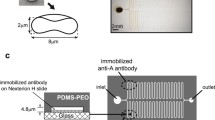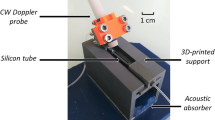Abstract
In channels with dimensions much less than 1 mm, fluids with viscosities similar to or higher than that of water and flowing at low velocities exhibit laminar behavior. This allows the adjacent flow of fluids and particles in a channel without mixing other than by diffusion. We demonstrate here the use of a 3-input microfluidic device known as a T-Sensor for the analysis of blood. A sample solution (e.g. whole blood), a receptor solution (e.g. an indicator solution), and a reference solution (a known analyte standard) are introduced into a common channel (T-Sensor), and flow side by side until they leave the structure. Smaller particles such as ions or small proteins diffuse rapidly across the fluid boundaries, whereas larger molecules diffuse more slowly. Large particles (e.g. blood cells) show no significant diffusion within the time the flow streams are in contact. Two interface zones are formed between the fluid layers. The ratio of a property (e.g. fluorescence intensity) of the outer portions of the two interface zones is a function of the concentration of the analyte, and is largely free of cross-sensitivities to other sample components and instrument parameters. This device allows, for example, one-time or continuous monitoring of the concentration of analytes in microliters of whole blood without the use of membranes or prior removal of blood cells. The principle is illustrated by the determination of pH and human albumin in whole blood and serum. Results are also presented for zero-gravity experiments performed with a T-Sensor on board a NASA experimental plane. Due to its microfluidic flow characteristics, a T-Sensor functions independently of orientation and strength of the gravitational field. This was demonstrated by exposing a T-Sensor to variations in gravity from 0 to 1.8 g in a NASA KC135A plane flying repetitive parabolic flight curves.
Similar content being viewed by others
Author information
Authors and Affiliations
Additional information
Received May 22, 1998. Revision November 10, 1998.
Rights and permissions
About this article
Cite this article
Weigl, B., Kriebel, J., Mayes, K. et al. Whole Blood Diagnostics in Standard Gravity and Microgravity by Use of Microfluidic Structures (T-Sensors). Mikrochim Acta 131, 75–83 (1999). https://doi.org/10.1007/s006040050011
Issue Date:
DOI: https://doi.org/10.1007/s006040050011




